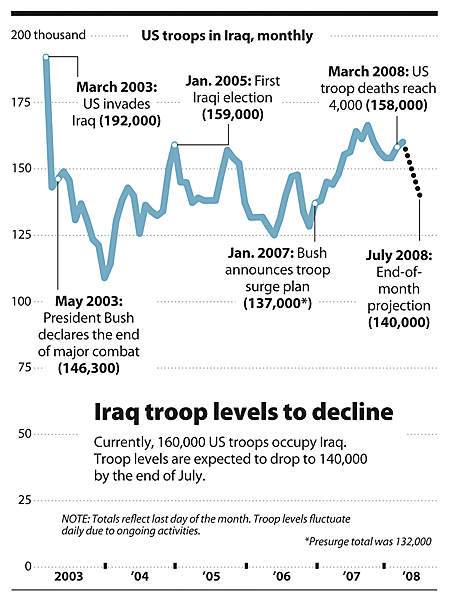Stresses still high on U.S. military
The US military for the immediate future continues to face daunting arithmetic: continued war, and too few warriors to go around.
Shorter tours in Iraq could help. President Bush's announcement Thursday that he is reducing Army combat deployments from 15 to 12 months for troops sent overseas later this year is aimed at reducing stress on soldiers and their families.
But 140,000 US troops will remain in Iraq at least through September, per the recommendation of top commander Gen. David Petraeus. Many military experts believe that stabilizing the situation there could require a substantial US presence for years to come.
The bottom line: Many ground units have deployed multiple times to Iraq, and "people are tired," according to the chairman of the Joint Chiefs of Staff Adm. Michael Mullen. Army leaders say the readiness of their brigades is down, their equipment is worn, and their ability to respond to any new contingency is questionable.
"We face a large and growing gap between our military commitments and our military capabilities. Something has to give," Andrew Bacevich, a West Point graduate and professor of international relations at Boston University, said in a Senate hearing Wednesday.
By most accountings Iraq is now the third-longest conflict in US history, shorter only than Vietnam and the Revolutionary War.
More than 500,000 US troops have served in Iraq since the 2003 invasion. Almost 200,000 have been deployed there more than once.
In public appearances this spring, Army leaders have been blunt about the effects of this pace on their soldiers. In a recent speech Army Chief of Staff Gen. George Casey, for instance, said that his service "is not a hollow or broken force" but that there is no question it is "stretched and stressed."
By the Army's count, it has conducted five surges into Iraq, including the most recent addition of extra brigade combat teams to tamp down Baghdad violence.
The current surge "took all the stroke out of the shock absorber for the US Army," Vice Chief of Staff Gen. Richard Cody told the Senate Armed Services Committee last week. He meant that if a conflict breaks out anywhere else in the world, there are no fully ready Army units that could be sent to handle it.
Army leaders are quick to say that morale remains high. But there are multiple signs of the emerging effect of this pace on the nature of the all-volunteer force. Captains – crucial midlevel managers of the Army – are choosing to leave at a substantial rate. The percentage of recruits who enter the Army with waivers because of past misconduct has more than doubled since 2004, to 13 percent so far this year.
In 2001, 91 percent of Army recruits were high school graduates. Last year that figure fell to 79 percent.
With only 12 months at home between tours, active Army units do not have time to do much else but rest and gather themselves for their return to Iraq.
"Our Army is out of balance," said General Cody.
The Army's long-term plan to restore balance includes increasing in size by 74,000 troops. That has been approved by the Bush administration, but construction of new units – not to mention recruiting the extra personnel in a time of war – takes time, and the target date for the expansion is 2011.
Meanwhile, the strategy for Iraq, per General Petraeus, involves no further drawdowns after July. After that, force reductions would await an improvement in conditions – or a different political situation in the United States.
To some experts, Cody's statements about the stresses in the force are a direct comment on Petraeus and the current course in Iraq.
"[The Army's] complaints are significant – they show a rift is developing within the military over the current strategy," says Loren Thompson, a military expert and chief operating officer of the Lexington Institute in Arlington, Va.
To others, they may represent the expectations of the Army's leadership that it can operate in a time of conflict as it typically has in peacetime.
Today's Army is far smaller than it was in, say, Vietnam. The fighting in Iraq understandably has strained it, says William Martel, author of the recent book "Victory in War" and an associate professor of international security studies at the Fletcher School at Tufts University in Medford, Mass.
"But in a war military, you have to cut corners to meet objectives," he says.
Mr. Bush's announcement that he is cutting the length of new tours in Iraq is a minor adjustment, adds Professor Martel, but also a welcome one.
It is intended to signal the military leadership that the Oval Office is at least listening to their deployment concerns, and to show troops that something is being done to ease their burdens.
"Progress comes in small doses," says Martel.






